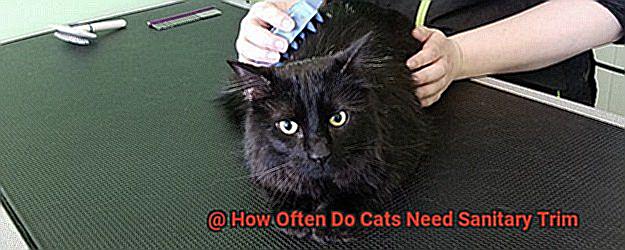Are you curious about how often cats need a sanitary trim? You’ve come to the right place.
We’ll cover everything from why cats need regular grooming, to how to keep them clean and healthy.
Plus, we’ll discuss the benefits of regular trims for your cat’s hygiene.
So, get ready to learn all about cat care—let’s get started!
What Does A Sanitary Trim Include?
A sanitary trim is an essential part of cat grooming and involves carefully removing fur from around the genitals and anus. This helps to keep the fur clean and tangle-free, as well as making it easier for cats to groom themselves. It is important to be mindful when trimming, making sure not to cut too close or nick the skin.
To ensure a hygienic environment, it is important to clean the area before and after the trim. This will help keep your cat healthy and happy while also preserving their appearance.
A sanitary trim is a simple but necessary step in maintaining your cat’s wellbeing. When done properly, it can help them look and feel their best.
How Often Do Cats Need Sanitary Trim?
Cats need regular sanitary trimmings to keep them healthy and happy. The frequency of these trims depends on whether your cat is spayed or neutered. For cats that are not spayed or neutered, a sanitary trim should be done every 3–4 weeks. For cats that are spayed or neutered, a sanitary trim should be done every 4-6 weeks.
These trimmings can help reduce the risk of skin infections and other health issues. It’s important to regularly check your cat’s sanitary area to make sure it is clean and free of debris.
Long-haired cats may require more frequent trims. To keep your cat’s sanitary area clean and debris-free, you can also use grooming tools such as combs or brushes.
Benefits of Regularly Trimming a Cat’s Sanitary Area
Cats are naturally clean animals, but regular grooming is essential for their overall wellbeing and happiness. One of the most important tasks in cats’ grooming is regularly trimming their sanitary area. This simple task brings many benefits that can help keep your cat healthy and comfortable.
Trimming the fur in the sanitary area helps reduce matting, which can cause discomfort for cats. It also helps to reduce odors from urine or feces and discourages parasites from taking up residence in the fur. Removing excess fur will also make grooming faster and less time-consuming.

To get started, you need just a pair of scissors made specifically for pet grooming.
Be gentle when trimming your cat’s sanitary area, and use sharp scissors that are specifically designed for pet grooming.
If you aren’t confident trimming your cat’s sanitary area yourself, you should bring them to a licensed groomer who can do it safely and effectively.
Regularly trimming a cat’s sanitary area is an important part of their overall wellbeing and happiness, so be sure to make it part of your cat’s regular grooming routine!
The Risks of Not Trimming a Cat’s Sanitary Area
Having a clean and well-maintained sanitary area for your cat is essential to their health.
If you fail to do so, it can lead to a host of issues. Urine and feces can accumulate in the fur, leading to skin irritation, infection, and even maggot infestation. Overgrown fur can also interfere with the cat’s ability to eliminate properly, resulting in constipation or other digestive issues.
Furthermore, long fur can cause discomfort as it mats and tangles, pulling on the skin and causing pain.
Not trimming a cat’s sanitary area increases the risk of parasites such as fleas and ticks.
So make sure you take care of your furry friend by keeping their sanitary area tidy and well-trimmed!
Preparing for a Sanitary Trim
Are you getting ready to give your cat a much-needed sanitary trim? If so, it’s essential to have the right tools and supplies on hand. To get started, make sure you have scissors, clippers, and a comb. Additionally, gather towels, pet shampoo, and cotton balls.
Before beginning the trim, ensure your cat is relaxed and comfortable. Show them lots of love and attention before starting. Then, brush their fur to remove any knots or tangles.

When it comes time for the trim itself, select a well-lit area with minimal distractions. Begin by securing a small area and working your way up until you reach your desired length.
How to Properly Trim a Cat’s Sanitary Area
It’s important to make sure that the job is done correctly and safely.
Sanitary trimmings can be carried out using a pair of scissors or clippers designed specifically for cutting pet fur.
However, it’s essential to use caution and avoid contact with the skin while trimming.
To get started, begin by combing the fur in the area around your cat’s sanitary area. This will help remove any knots and tangles that may be present.
Then, slowly and carefully cut away any excess fur in small sections, starting from the base and working your way up to the tip of the tail. Make sure not to trim too close to the skin, as this may lead to irritation or even injury.
Once finished, brush out any remaining loose hair and check for any areas that need additional trimming.
It can also be beneficial to have a treat nearby during this process. Cats can become tense or scared during this process, so having something positive like a treat can help them associate the event with something pleasant.
After you’re done trimming, don’t forget to reward your cat; they will love it.
Tips for Making the Process Easier for You and Your Pet
Are you looking for ways to make the process of trimming your cat’s sanitary area easier and more enjoyable for both you and your pet? Here are eight tips to help make the process simpler and more stress-free.
- Get the Right Tools: Before beginning, make sure you have the right tools to trim your cat’s sanitary area. You will need a pair of scissors, a comb, and possibly a razor.
- Be Patient and Gentle: Trimming your cat’s fur requires patience and gentleness. Speak in soothing tones and offer plenty of praise when they are behaving well.
- Use a Grooming Glove or Brush: To help remove excess fur from the area before trimming, consider using a grooming glove or brush. This is especially beneficial if your cat has thick fur or mats in its fur.
- Start Slowly: To get your pet used to the process, start slowly by doing it in small increments at first, then gradually increasing the amount of time spent on each session until they are comfortable with it.
- Avoid Forcing Anything: Never force or rush them into anything they don’t want to do, as this can lead to anxiety and stress for both you and your pet.
- Seek Professional Help: If you have any doubts about how to properly trim your cat’s sanitary area, consult with a professional groomer or veterinarian who can provide guidance on how to proceed safely and effectively for both you and your pet.
- Keep Clippers Clean: If you are using clippers, it is important to keep them clean and well-maintained in order to avoid any skin irritation or infection from bacteria buildup on the blades.
- Reward Good Behavior: After trimming, use a soft brush to remove any remaining loose fur from your cat’s body before giving them a treat or toy as a reward for being so cooperative.
Aftercare for Your Cat Following a Sanitary Trim
After a sanitary trim, your cat needs extra care and attention. Here are some tips to help them recover quickly and easily.
First, make sure your cat has plenty of fresh water and soft food. Their skin may be sensitive after the trim, so it’s important to provide extra nourishment.
Second, keep an eye out for any signs of infection or inflammation. Contact your veterinarian right away if you notice redness, swelling, itching, or discharge around the cut area.
It’s also important to keep your cat’s area clean and free of debris. Regularly brush their fur and make sure the area is dry to prevent infection from spreading in the trimmed area.
Try to limit your cat’s activity for a few days following the trim. This will help them heal more quickly and reduce the risk of further irritation or infection.
Also Read: What Happens If You Don’t Trim Your Cat’s Nails?
Conclusion
In conclusion, it’s essential to keep up with regular sanitary trims for cats. Depending on their spayed/neutered status, they may need a trim every 3-4 weeks (unspayed/unneutered) or 4-6 weeks (spayed/neutered).
Regular trimmings help reduce matting and odors, as well as discourage parasites from settling in their fur. To ensure a safe and successful trim, make sure you have the right tools and supplies on hand, and take extra caution when trimming.
Afterward, show your cat lots of love and care, along with nutritious food and water for optimal recovery.







